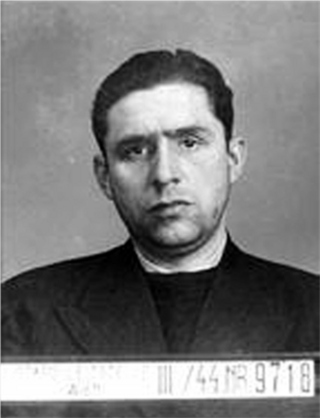DDr. Heinrich Maier

Personalia
Born:
Died:
Profession:
Persecution:
Imprisonment 16.09.1944 - 22.11.1944,
Mauthausen concentration camp 22.11.1944 - 18.03.1945,
Imprisonment 18.03.1945 - 22.03.1945,
Murdered on 22.03.1945
Memberships
Curriculum Vitae
Heinrich Maier is the son of an imperial and royal official of the Austrian State Railways. He first attended grammar school in St. Pölten and then in Leoben. After graduating from high school in 1926, he entered the Vienna seminary and was accepted into the student fraternity Nibelungia shortly afterwards in November. He enrolled at the University of Vienna and studied there from 1926 to 1928. He then moved to Rome from 1928 to 1930 to study scholastic philosophy at the Pontifical Gregorian University, where he obtained a doctorate in philosophy in 1930, as did his fellow student Franz König (1905-2004), who later became Archbishop of Vienna and a cardinal. After returning to Vienna, he continued his theological studies from 1930 to 1932. In 1932, he was ordained a priest in St. Stephen's Cathedral in Vienna. Between 1932 and 1939, he worked as a chaplain in Schwarzau am Steinfeld and Mödling - St. Othmar in Lower Austria. On September 1, 1935, he took up his last pastoral post in the parish of Gersthof, St. Leopold (Vienna XVIII). In addition, he primarily looked after young students and, from 1936, taught religion at the technical and commercial college in Mödling and at the secondary school of the "Albertus-Magnus-Schulwerk der Marienbrüder".
He passed his teaching exam in 1938. With the violent suppression and dissolution of the denominational schools by the National Socialists, his teaching career as a teacher also came to an end. He remained chaplain in St. Leopold and used the time to complete his doctorate in theology, which he did on July 25, 1942. He is a functionary of the VF and the Austrian Young People.
From 1940, he works with a loose network of resistance groups that maintain contacts with the American secret service OSS. He founded his own group, the group "Maier-Messner-Caldonazzi". Tasks of the underground work are: Carrying out acts of sabotage, distributing leaflets, getting people in danger across the border, obtaining the necessary funds, making people appear unfit for military service and establishing contacts with the Allies. Heinrich Maier had an intermediary in Switzerland, the theologian DDr. Otto Karrer (1888-1976). In 1942, he sent him a message to be passed on to the British ambassador in Bern:
As the American OSS employee is a double agent, the group "Maier-Messner-Caldonazzi" is exposed. Following a complaint, Heinrich Maier was arrested by the Gestapo on March 28, 1944 after morning mass in the sacristy of Gersthofen parish church and interrogated on Morzinplatz. In the interrogation on April 27, 1944, he stated, among other things, that he had hoped to prevent further air raids on Austrian cities by providing information about the "armaments factories in the Ostmark" and that this would spare the other industries that would be needed after the war, as well as the civilian population.
In the main trial before the 5th Senate of the Supreme Administrative Court sitting in Vienna, he was then found guilty together with the other defendants on October 28, 1944 of "preparation for high treason" by "participation in a separatist association" and sentenced to death. The reasons given by the VGH included the following:
"In 1942, the defendant Maier believed that he could foresee Germany's defeat in the present war with certainty. [...] Maier wanted to demonstrate to the enemy abroad that a movement hostile to National Socialism already existed in the former Austrian lands, which could be reckoned with if necessary. [...] The accused was soon surrounded by a number of people who agreed with his political views and, like him, were determined to contribute to the re-establishment of an independent Austrian state. This was to have a monarchist form of government and include Bavaria and South Tyrol in addition to the Austrian lands."
Despite the death sentence, he was taken to the Mauthausen concentration camp from November 22, 1944 to March 18, 1945, as it was hoped that the possibilities available there would allow details about his resistance group to be squeezed out of him through torture. He put up with all the harassment and the most terrible tortures - such as being tied to the window cross without clothes on - in order to cover for his friends. On March 18, 1945, according to the eyewitness report, Heinrich Maier was captured by fellow prisoner Lois Weinberger together with Lois Weinberger and others. with Felix Hurdes and Leopold Figl back to the provincial court in Vienna. Until his sentence was carried out, he was deployed several times to defuse unexploded bombs and explosive devices in the various districts of Vienna. On March 22, 1945, the last day of execution before the liberation of Vienna by the Allies, Heinrich Maier was murdered by guillotine in the Grey House. He called out to his fellow prisoners on the way to the scaffold as he blessed them in passing:
"Long live Christ the King! Long live Austria!"
The assessment of the episcopal chancellery states, among other things:
"It is said that Chaplain Maier took the guilt of all his members upon himself and made such an impression on the chairman during his interrogation with his witty defense that all the mockery with which he was otherwise generous died on his lips."
.
The body, originally buried in a shaft grave at the central cemetery, was reburied in a grave of honor at the cemetery in Neustift am Walde after the war.
Places
Persecution:
Honoring:
Place of activity:
Death Place:
Citations
- Krause, Peter/Reinelt, Herbert/Schmitt, Helmut (2020): Farbe tragen, Farbe bekennen. Katholische Korporierte in Widerstand und Verfolgung. Teil 2. Kuhl, Manfred (ÖVfStG, Wien), p. 208–210.
Hommage des Dokumentationsarchiv des Österreichischen Widerstands unter www.doew.at; Stand: 02.10.2022.
